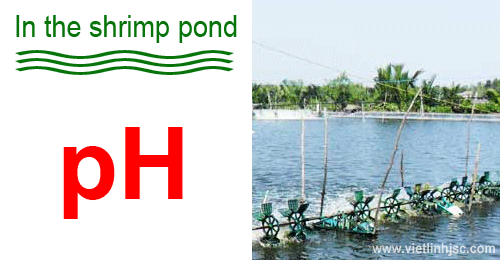In aquaculture, changes in the pH values can affect the physical elements, chemistry, and biology of water environment as well as the health of shrimp or fish.
- The appropriate pH values for black tiger prawn farming are pH = 7.2 to 8.8. The best conditions are from 7.8 to 8.5.
- The fluctuation of pH during a day should not exceed 0.5. If the pH values change significantly, they can make shrimp and fish shocked, weakened, or stop eating.
- If the high or low levels of pH extend for a long period time, they will make shrimp grow slowly, stunting and susceptible to diseases.
The pH of water depends on these factors:
1 . Natural ground/platform of the farming ponds:
• Acid sulfate soil (acidic alum soil, acidic soil) makes the pH of water low and fluctuated.
• If it rains heavily, aluminum might be washed away from dikes into ponds; dikes might soak up water, or the levels of water in trenches might be higher than the levels of water in ponds. These situations will increase the amount of aluminum and reduce the pH in ponds.
• If we plow the alum ground, aluminum will leak from the lower levels to the upper levels of the ground.
2 . Algae and microorganisms in ponds:
• Algae and microorganisms which use CO2 can affect the pH of water.
• A large amount of algae will make the pH significantly fluctuated during the day. Too much algae also makes the pH high (8.8 to 9.1) in the afternoon.
• When algae dies, the pH values in ponds will be reduce.
• In shrimp farming areas where the salinity is low, or during rainy season, algae often increase.
• The balance between algae and microorganisms needs to be maintained to stabilize the levels of pH.
The pH of water in ponds often increases during the daytime and decreases at nighttime. According to Viet Linh’s experiences, it is necessary to measure pH at least 2 times/day to monitor water, identify causes of pH fluctuations, and timely control the negative situations.

Some simple solutions that can stabilize the pH of water in aquaculture ponds:
1 . Settle the bottom environment of the ponds:
Use quicklime or slaked lime to renovate the ponds’ bottoms.
Check the pH of soil at the bottom of the ponds . The lower the pH, the more we have used lime to increase the pH value.
• pH > 6: use 300 - 600 kilograms of lime/hectare.
• pH < 5: use 1500 - 2000 kilograms of lime/hectare.
2 . Water Treatment:
2.1 . When the pH is low:
• When the pH drops too low, use lime or slaked lime with a dose of 0.5 - 10 kilograms/1000 m2. Before it rains, spread lime around the pond, about 10 kilograms/1000 m2.
• When the pH in the morning is from 7.5 to 7.8, and the pH difference between the morning and the afternoon exceeds 0.3: If the color of water is pure, use 30 – 50 kilograms of dolomite lime/1600 m2 (180-300 kilograms/hectare) in the afternoon continuously in 2 to 3 days.
• When the pH in the morning is from 7.5 to 7.8, and the pH difference between the morning and the afternoon is 0.5: If the water color is normal, use CaCO3 lime at 180-300 kilograms/hectare every afternoon until the pH values are higher and stop fluctuating too much in a day.
2.2 When the pH is high:
• If pH > 8.3 in the morning: use sugar with a dose of 1-3 kilogram/1000 m2, or use the appropriate probiotics to stimulate the development of microbial decomposition. These microorganisms decompose organic detritus in the ponds. CO2 will be produced and the pH value will be reduced.
• The pH value can also be decreased by changing water in ponds.
• In case of a sudden increase in sunny afternoons, when the pH > 9.0, use formalin with a dose of 3-4 ml/m3
If the pH fluctuation is large during the day (> 0.5), the hardness (the amount of CaCO3) in ponds is low, algae might grow and develop quickly causing algal blooms while organic detritus might increase. In these cases, use dolimite lime with a dose of 100-200 kilograms/hectare to increase water hardness and buffering agents. Water should also be changed to stabilize the growth of algae.
© 2014/2018/2019 Viet Linh